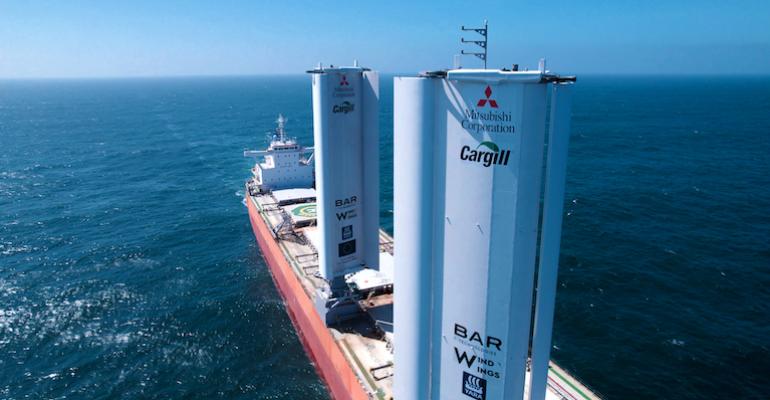“I knew then that I would never see sailing like this again. When such ships as this went it would be the finish. The windbelts of the world would be deserted and the great West Wind and the Trades would never blow on steel rigging and flax canvas again.”
That was 1939- and nineteen-year-old Eric Newby, aboard the four masted 5,300 dwt steel barque Moshulu, recalled a wild day in the southern ocean, and a day’s run of 333 miles. In his book The Last Grain Race, still in print, Newby wrote of the furious determination aboard the Eriksen barque, from her master to the lowly apprentices, to wring the last possible ounce of energy from the forces of the wind.
The final days of commercial sail, with its casual disregard of safety of life and limb, of under-manned ships scratching around for the few freights for which steamships could not be bothered, was a very different world. But the extraordinary illustrations published this month of the big bulker Berge Olympus, with four gigantic winged sails spread, makes one wonder, just perhaps, whether the West Wind and the Trades might become important once again. This ship, following along behind the smaller Pyxis Ocean of Cargill, with two of these huge sails, represents a serious move to demonstrate that wind has an important role to play in decarbonising maritime trade.
The Bergebulk ship, spreading some 3,000 square metres of sail, each foldable unit 20m wide and 37.5m above the deck has the potential to save six tons of fuel every day along with nearly 20 tons of CO2. The steel and composite WindWings “rig” – if it can so be termed, designed by a combination of BAR Technologies and Yara Marine Technologies, is claimed to move wind assistance to a whole new level.
There is certainly a growing interest in wind assistance, going beyond the kites and rotors that have been seen in many different ship types, as owners have been trialling several different methodologies. And taking wind assistance deepsea, into routes that can genuinely be said to favour some real help from the wind on extended voyages, makes sense. Running between Brazil and China and using the prevailing winds intelligently, there ought to be real savings to be gained.
Studying the old wind and current charts, which were relied upon in the century before commercial sail vanished, ought to produce dividends, almost regardless of which ocean in which the ship is sailing. It is a matter of rebuilding old skills and re-imagining traditional knowledge as important, after decades when it had become somewhat peripheral to mainstream shipping.
Thus, for years, people running power driven ships have rather ignored nature, other than using forecasting to avoid storms. Quite early on naval architects became convinced that under about 50 knots streamlining superstructures would be pointless, so generations of seafarers have faced the reality that ship speed instantly reduces once the wind direction is from forward of the beam.
Listen to a recent podcast episode on rotor sails
The lawyers haven’t helped; judgements in charter party disputes favouring ships which have taken the most direct route, rather than those which have tried to keep the wind and currents onside. It is only very recently that designers have thought about making superstructures less like a brick, and building huge “windshield” onto containership bows. It clearly works, rather proving that one should not believe everything that the scientists tell you is “settled".
It is significant that the WindWings equipment has been retrofitted to existing bulk carriers, neither of which would have been originally designed for anything other than maximising cargo deadweight. It would be fascinating to see what additional advantages there might be in designing a hull that was optimised for both efficiency under wind and cargo volume.
A lot has gone into the development of these rigs – advanced aerodynamic design that has emerged from both aviation and yacht racing, along with the use of super-strong composite materials. There is also a debt to the Japanese experiments of the 1980s, which produced workable designs for semi-rigid, automatic and rigging-less sail outfits. But perhaps there is also some inspiration from those earlier, hardier generations, which drove the old wind ships around the world.
Copyright © 2024. All rights reserved. Seatrade, a trading name of Informa Markets (UK) Limited.
Add Seatrade Maritime News to your Google News feed.  |

